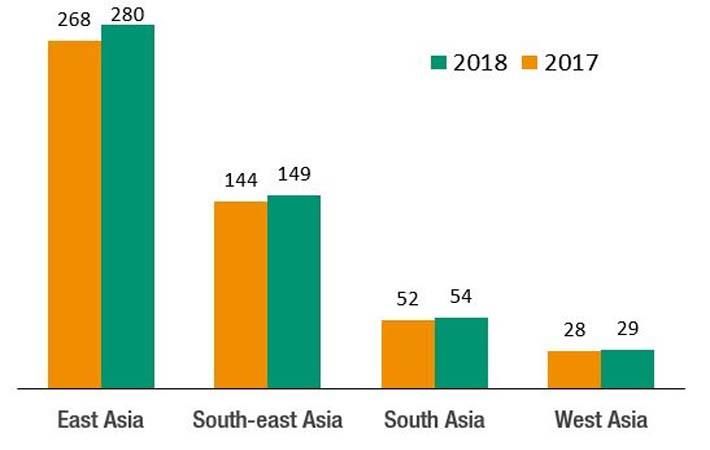Interviews
Developing Asia gets over $500 bn in investments: UNCTAD
14 Jun '19
4 min read

Pic: UNCTAD
Foreign direct investment (FDI) inflows to developing countries in Asia rose by 3.9 per cent to $512 billion in 2018, according to the World Investment Report 2019 of the United Nations Conference on Trade and Development (UNCTAD). The region remained the world’s largest FDI recipient, absorbing 39 per cent of global inflows in 2018, up from 33 per cent in 2017.
Growth occurred mainly in China, Hong Kong, Singapore, Indonesia and other Association of Southeast Asian Nations (ASEAN) countries, as well as India and Turkey, UNCTAD said in a press release.
“The prospects for FDI flows to the region in 2019 are moderately optimistic, thanks to a favourable economic outlook and ongoing efforts to improve the investment climate in several major economies,” said James Zhan, director of UNCTAD’s division on investment and enterprise.
FDI inflows to South Asia increased by 3.5 per cent to $54 billion. Investment in India, the sub-region’s largest recipient, rose by 6 per cent to $42 billion, with strong inflows in manufacturing, communication, financial services and cross-border merger and acquisition (M&A) activities.
Flows to Bangladesh and Sri Lanka rose to a record level, to $3.6 billion and $1.6 billion, respectively. Pakistan witnessed a 27 per cent decline in investment to $2.4 billion.
FDI to East Asia rose by 4 per cent to $280 billion in 2018 with inflows to China–the largest developing economy recipient–increasing by 4 per cent to an all-time high of $139 billion, accounting for more than 10 per cent of the world’s total. Foreign investors established more than 60,000 new companies in the country in 2018.
Flows to Hong Kong rose by 4 per cent to $116 billion, mostly in services sector operations.
FDI to South Korea dropped by 19 per cent to $14 billion due to a significant decrease in intra-company loans.
South-east Asia received a record level of investment, up 3 per cent to $149 billion.
Robust investment from Asian economies and strong intra-ASEAN investments supported FDI growth in the sub-region.
The growth was driven by strong investment mainly in Singapore, Indonesia, Viet Nam and Thailand.
Manufacturing and services, particularly finance, retail and wholesale trade, including the digital economy, continued to underpin inflows to the sub-region. FDI flows to some countries such as Malaysia and the Philippines declined.
West Asia, with the largest increases in investment in Turkey and Saudi Arabia, saw a 3 per cent rise in investment to $29 billion, halting an almost continuous 10-year downward trend.
However, inflows were still only one third of the $85 billion peak in 2008 and remained uneven.
Four countries—Turkey, the United Arab Emirates, Saudi Arabia and Lebanon–absorbed approximately 90 per cent of FDI in this subregion. Outflows from Asia declined by 2.5 per cent to $401 billion. The region remained a significant source of investment, representing 40 per cent of global FDI outflows in 2018. The decline was mainly due to reduced investment from China, for the second consecutive year, and from Singapore.
Outflows from East Asia dropped to $271 billion and those from south-east Asia ($70 billion) and South Asia ($11 billion) were flat.
Outward FDI from West Asia peaked at $49 billion in 2018, up from $39 billion in 2017 mainly on increased investment from Saudi Arabia, the United Arab Emirates and Turkey.
Outward investment from some economies such as the Republic of Korea and Thailand increased.
All sub-regions in developing Asia are expected to receive higher inflows. Prospects are underpinned by a doubling in value of announced greenfield projects in the region, suggesting continued growth potential for FDI.
However, uncertainties stemming from global trade tensions could weigh on the mood.
On outflows, bilateral cooperation under the Belt and Road Initiative is expected to continue to encourage outward FDI along the routes, particularly in infrastructure.
Of the 5,400 special economic zones (SEZs) in the world, more than 4,000 are in developing countries in Asia.
China hosts the most, at more than 2,500. South-east Asian countries together host more than 700. South Asia hosts upward of 450 zones and West Asia’s tally surpasses 200.
China’s continued policy experiment in large-area zones, investment facilitation measures and relaxation of foreign ownership in sectors such as finance and health care in pilot free trade zones are expected to draw future investments.
Other countries in the region continue to build more SEZs. South-east Asian countries are planning 200 additional zones, according to the UNCTAD report. India, Bangladesh and Pakistan together have more than 200 zones in the pipeline. (DS)
Growth occurred mainly in China, Hong Kong, Singapore, Indonesia and other Association of Southeast Asian Nations (ASEAN) countries, as well as India and Turkey, UNCTAD said in a press release.
“The prospects for FDI flows to the region in 2019 are moderately optimistic, thanks to a favourable economic outlook and ongoing efforts to improve the investment climate in several major economies,” said James Zhan, director of UNCTAD’s division on investment and enterprise.
FDI inflows to South Asia increased by 3.5 per cent to $54 billion. Investment in India, the sub-region’s largest recipient, rose by 6 per cent to $42 billion, with strong inflows in manufacturing, communication, financial services and cross-border merger and acquisition (M&A) activities.
Flows to Bangladesh and Sri Lanka rose to a record level, to $3.6 billion and $1.6 billion, respectively. Pakistan witnessed a 27 per cent decline in investment to $2.4 billion.
FDI to East Asia rose by 4 per cent to $280 billion in 2018 with inflows to China–the largest developing economy recipient–increasing by 4 per cent to an all-time high of $139 billion, accounting for more than 10 per cent of the world’s total. Foreign investors established more than 60,000 new companies in the country in 2018.
Flows to Hong Kong rose by 4 per cent to $116 billion, mostly in services sector operations.
FDI to South Korea dropped by 19 per cent to $14 billion due to a significant decrease in intra-company loans.
South-east Asia received a record level of investment, up 3 per cent to $149 billion.
Robust investment from Asian economies and strong intra-ASEAN investments supported FDI growth in the sub-region.
The growth was driven by strong investment mainly in Singapore, Indonesia, Viet Nam and Thailand.
Manufacturing and services, particularly finance, retail and wholesale trade, including the digital economy, continued to underpin inflows to the sub-region. FDI flows to some countries such as Malaysia and the Philippines declined.
West Asia, with the largest increases in investment in Turkey and Saudi Arabia, saw a 3 per cent rise in investment to $29 billion, halting an almost continuous 10-year downward trend.
However, inflows were still only one third of the $85 billion peak in 2008 and remained uneven.
Four countries—Turkey, the United Arab Emirates, Saudi Arabia and Lebanon–absorbed approximately 90 per cent of FDI in this subregion. Outflows from Asia declined by 2.5 per cent to $401 billion. The region remained a significant source of investment, representing 40 per cent of global FDI outflows in 2018. The decline was mainly due to reduced investment from China, for the second consecutive year, and from Singapore.
Outflows from East Asia dropped to $271 billion and those from south-east Asia ($70 billion) and South Asia ($11 billion) were flat.
Outward FDI from West Asia peaked at $49 billion in 2018, up from $39 billion in 2017 mainly on increased investment from Saudi Arabia, the United Arab Emirates and Turkey.
Outward investment from some economies such as the Republic of Korea and Thailand increased.
All sub-regions in developing Asia are expected to receive higher inflows. Prospects are underpinned by a doubling in value of announced greenfield projects in the region, suggesting continued growth potential for FDI.
However, uncertainties stemming from global trade tensions could weigh on the mood.
On outflows, bilateral cooperation under the Belt and Road Initiative is expected to continue to encourage outward FDI along the routes, particularly in infrastructure.
Of the 5,400 special economic zones (SEZs) in the world, more than 4,000 are in developing countries in Asia.
China hosts the most, at more than 2,500. South-east Asian countries together host more than 700. South Asia hosts upward of 450 zones and West Asia’s tally surpasses 200.
China’s continued policy experiment in large-area zones, investment facilitation measures and relaxation of foreign ownership in sectors such as finance and health care in pilot free trade zones are expected to draw future investments.
Other countries in the region continue to build more SEZs. South-east Asian countries are planning 200 additional zones, according to the UNCTAD report. India, Bangladesh and Pakistan together have more than 200 zones in the pipeline. (DS)
Fibre2Fashion News Desk – India
Popular News
Leave your Comments
Editor’s Pick
































-Ltd..jpg?tr=w-120,h-60,c-at_max,cm-pad_resize,bg-ffffff)





.jpg?tr=w-120,h-60,c-at_max,cm-pad_resize,bg-ffffff)
.jpg?tr=w-120,h-60,c-at_max,cm-pad_resize,bg-ffffff)






